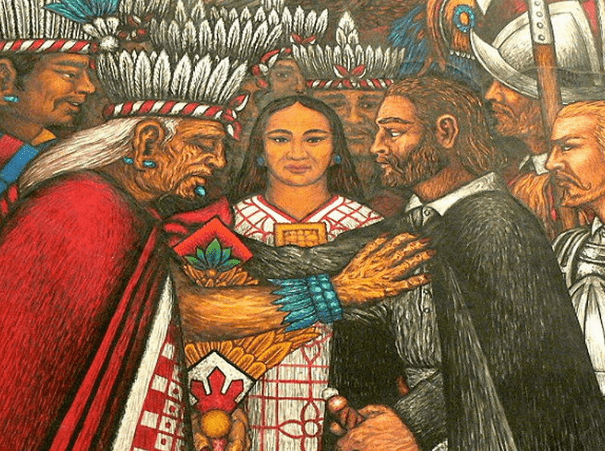Winner of the Fall 2016 StMU History Media Award for
Best Article in the Category of “People”
Best Article in the Category of “World History”
Largely due to the importation of disease and use of superior weapons, the Spaniards were able to conquer the Aztec capital of Tenochtitlan, kill the empire’s last emperor, Cuauhtémoc, and bring the Aztec empire to an end. Few know of La Malinche, the indigenous interpreter of Hernán Cortés, whose linguistic abilities were used to facilitate important conversations between the Spaniards and the indigenous leaders. Without the help of La Malinche, perhaps the Aztec empire would have survived.
Born between 1502 and 1505, La Malinche was named Malinalli Tenepal, the first part of her name being a Nahuatl term for the twelfth day of the month in correspondence to the Aztec calendar, and the second part of her name meaning “lively.” She was born of nobility in Paynala within the region of Veracruz. Her troubles started at a young age after the death of her father. La Malinche was ousted from her home to ensure her new half-brother received the inheritance of the family instead of her, since she was the eldest child. She was given to “some Indians of Xicalango.”1 Then the Indians gave her to a nobleman in Tobasco, a region in the Yucatan. When Cortés arrived to Tobasco, he was offered twenty slaves, one of them being La Malinche. Having lived in Veracruz, a Nahuatl-speaking region, and then being sold into a Maya-speaking region, La Malinche knew both languages and she was soon recognized for the linguistic talents that could benefit Cortés in his conquests.2

The few glimpses of La Malinche and how her presence as an interpreter accelerated the fall of the Aztec empire can be found in the writings of the Spanish explorers, specifically from Hernán Cortés, her “lord and master.”3 From the second letter Hernán Cortés wrote to Emperor Charles V, dated October 30, 1530, Cortés speaks of La Malinche as “a female interpreter that I had, who was a native of this country, and whom I obtained at Putunchún on the Rio Grande.”4 This confirms the vague aspects of her life that we already know. But most importantly, in this context, this letter goes on to tell of a scenario in which La Malinche saved the Spaniards from an ambush by the Cholulans. La Malinche was told by the wife of a native leader that they planned to attack the Spaniards and if La Malinche came with them, she would be protected. La Malinche delivered this message to Cortés, which ultimately led to the massacre of Cholula and provided a direct path to march towards Tenochitlan, the capital of the Aztec empire.5 This leads to the question of whether or not La Malinche was a traitor or a survivor. Did she explicitly want the Aztec empire to fall or did she just want to save herself from the carnage?
With no traces of primary sources from La Malinche herself, her story has been retold by various scholars without much consistency, nothing ever being certain. Up until the twentieth century, La Malinche was viewed as a traitor to her country Mexico. In 1861, on the celebration day of Mexico’s Independence, Ignacio “El Nigromante” Ramírez, a Mexican journalist, addressed the Mexican people by saying, “One of the mysteries of fate is that every Mexican owes his downfall and disgrace to a woman, and to another woman his salvation and glory; the myth of Eve and Mary is reproduced everywhere; we indignantly remember Cortés’s mistress and will never forget, in our gratitude to Doña María Josefa Ortiz.”6 La Malinche is seen as playing a key role in the subjugation of the Mexican peoples to Spain, while Doña María Josefa Ortiz did the contrary and liberated the country. However, many Chicana writers and modern scholars are trying to rewrite the tale of La Malinche to understand the complexities of her choices and to vindicate her. For example, Gloria Anzaldua promotes the idea that La Malinche had a “new consciousness,” that she voluntarily served as the interpreter of Cortés not only to save herself, but also because she knew that a new mestiza culture was going to be born (especially considering she had a son with Cortés in 1524).7 She made a conscious effort to exchange language and cultural aspects from each side in order to facilitate the emergence of the new mestiza society; however, with that came brutal consequences in the shape of warfare and mass death in the New World.
Whether or not La Malinche’s role as Cortés’s interpreter was traitorous, simply an effort to survive, or some other complex reason involving love for Cortés, hate for the Aztec empire for the cruelty she faced after being ousted from her home, or promotion of the new mestiza culture, no one will ever know the true story of the Indian, slave woman who traveled alongside Cortés towards the culmination of the Aztec empire.
- Bernal Castillo del Díaz, The Discovery and Conquest of Mexico, 1517-1521 rev. American ed., trans. A.P. Maudsley (New York: The Noonday Press, 1965), chap. 22-23. ↵
- Pilar Godayol, “Malintzin/ La Malinche/ Doña Marina: re-reading the myth of the treacherous translator,” Journal of Iberian and Latin American Studies 18, no. 1 (April 2012): 61-68. ↵
- Castillo del Bernal, chap 23. ↵
- Hernan Cortes to Emperor Charles V, October 30, 1520, in Letters of Despatches of Hernando Cortes, to the Emperor Charles V., trans. (New York: Wiley and Putnam, 1843), letter II. ↵
- Hernan Cortes to Emperor Charles V, October 30, 1520, in Letters of Despatches of Hernando Cortes, to the Emperor Charles V, letter II. ↵
- Rosario Pérez-Lagunes, “The Myth of La Malinche: From the Chronicles to Modern Mexican Theater” (PhD dis., Virginia Polytechnic Institute and State University, 2001), 24. Although she was of Spanish descent, Doña María Josefa Ortiz was born in Valladolid, Mexico in 1768 and identified herself as Mexican. She and her husband were both a part of the rebellion that ultimately led to Mexico’s independence from Spain in 1824. ↵
- Godayol, 68-70. ↵



230 comments
Eugenio Gonzalez
First of all, congratulations on your award and article. I do not only congratulate you for your award but for the resiliency that you demonstrated in writing an article on a historical figure that did not have a lot of information. Nevertheless, it is interesting how history can be cruel to some people, in this case ”La Malinche.” Before reading this article, I was taught that ”La Malinche” was a traitor. Still, after reading the article, I have doubts if ”La Malinche” was a traitor, and now I can understand why ”La Malinche” decided to help Cortez and the Spanish conquer the Aztec empire.
Jorge Martinez
I appreciate that the author allows the reader to come to their own conclusion about La Malinche. Personally, I think she is not betraying anybody. Her own people abandoned her, so if anything they betrayed her first. This story also shows how important information can be. Without Tenepal’s interpretations, Cortez and his men would mostly likely have succumbed to many native sneak attacks. At the end of the day, Tenepal was really looking out for herself.
Kimberly Rivera
I’ve always loved to read about the history of the Aztec empire and as I read this article I was able to learn more about an important figure. La Malinche’s story is a story that will be carried along for a long time and the important key role she had for Cortes to be able to conquer the aztec empire. My curiosity about weather she meant to betray the Aztec empire or if it was a single effort to save herself and end her suffering in a revengful has grown more after reading this amazing article.
Kenneth Cruz
First, congratulations on receiving an award for your article! I found it to be very interesting especially because we were covering the fall of the Aztec empire in class recently. It’s amazing how much mystery is shrouded around this one woman. Were her actions traitorous? Or was she simply saving herself? I am personally having a hard time forming an opinion on the matter. I want to learn more about her story so I can have an answer to those questions raised.
Mateo Ortega
This is a great read, right from the start I am engaged and it shows a different perspective from all the stories we have heard from empires being conquered. This whole article was extremely well written from start to end. Congratulations on all the awards they are well deserved and this is by far one of my favorite articles.
Guadalupe Altamira
Very interesting lady with a background that didn’t get better over time. Many people saw her as someone who betrayed the Native in Mexico but there are always two sides to the story. Maybe she wanted to live peacefully after being outcasted by her family and given to others as a slave. The argument in both perspectives makes this article very interesting and really makes you think about the different opinions people have. This article really made an unknown slave woman see differently from the reader’s eyes.
Brody Ticer
WOW! Very interesting read! Congrats on the awards. We learn about the story as a whole in class but when you read the inside stories like this, it engages you so much more into the story. I really like the structure used and the amount of detail that was added. The introduction really tied me in as well. There is always the details in these stories that sometimes go untouched. I am glad this was brought to light in such a good way!
Vanessa Preciado
Hey Mariana, I really enjoyed this article, I will admit the languages and some of the cities and peoples names in this article are kind of hard to say, but it gets easier as we keep reading them over again. What caught my attention is how her mother had given her away at a young age after her father died in order for her half brother to receive an inheritance. That is very sad and such a shame to me. People ask if she is a traitor or a survivor? I cant help but think that if I was openly given out to different people by my own mother at a young age over an inheritance, I would definitely help take out the Aztecs (the people who threw her out) but that’s just me. She was young and left to fend for herself, and I think she did a really good job of it. She even learned Spanish in just a few weeks time to benefit her. It was her way of living, And I say she did well for herself. Great article Mariana! I really like this one.
Dylan Vargas
The way the article starts is what I like the most about the article, it sets us up to the introduction of what the story is about and what kind of setting or time we are in. The way she brings the thesis of the story and the entire question of the article. Then goes on to explain the person more in detail and what lead to ultimately the story and the details of the question that is being asked. It gives the reader the points as well as keeping that question in the back of their mind as they read the article and then bringing it back at the end to finally put things together.
Ashly Orta
Congrats on the awards! Your article on La Malinche definitely deserves both awards. Honestly, more people need to know about her considering how inportant her actions were to the downfall of the Aztec Empire. A pity there is almost nothing about her other than Cortez’s letters to Emperor Charles V, it would have been interesting to have some primary source from her. Having something like that would help people know whether she is a traitor or survivor, maybe even both.